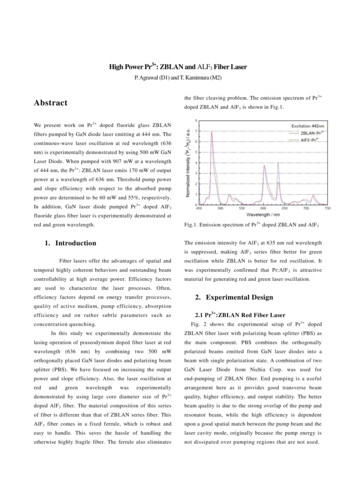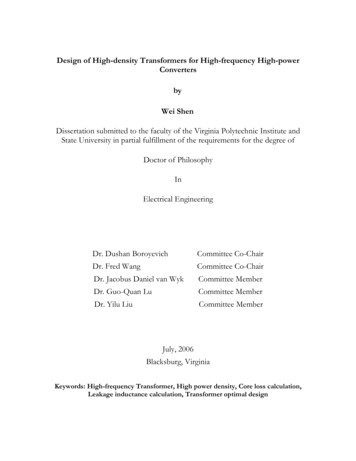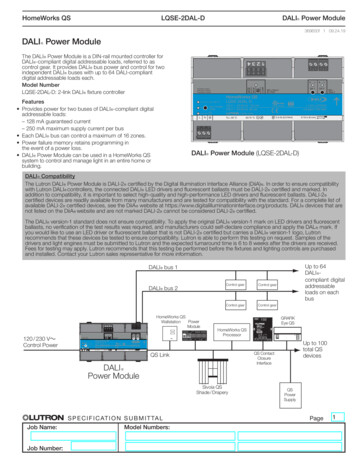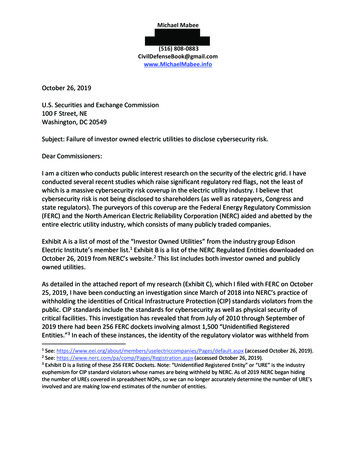
Transcription
High Power Pr3 : ZBLAN and ALF3 Fiber LaserP. Agrawal (D1) and T. Kamimura (M2)the fiber cleaving problem. The emission spectrum of Pr 3 Abstractdoped ZBLAN and AlF 3 is shown in Fig.1.We present work on Pr 3 doped fluoride glass ZBLANfibers pumped by GaN diode laser emitting at 444 nm. Thecontinuous-wave laser oscillation at red wavelength (636nm) is experimentally demonstrated by using 500 mW GaNLaser Diode. When pumped with 907 mW at a wavelengthof 444 nm, the Pr 3 : ZBLAN laser emits 170 mW of outputpower at a wavelength of 636 nm. Threshold pump powerand slope efficiency with respect to the absorbed pumppower are determined to be 60 mW and 55%, respectively.In addition, GaN laser diode pumped Pr 3 doped AlF 3fluoride glass fiber laser is experimentally demonstrated atFig.1. Emission spectrum of Pr 3 doped ZBLAN and AlF 3red and green wavelength.1. IntroductionThe emission intensity for AlF 3 at 635 nm red wavelengthis suppressed, making AlF 3 series fiber better for greenFiber lasers offer the advantages of spatial andoscillation while ZBLAN is better for red oscillation. Ittemporal highly coherent behaviors and outstanding beamwas experimentally confirmed that Pr:AlF 3 is attractivecontrollability at high average power. Efficiency factorsmaterial for generating red and green laser oscillation.are used to characterize the laser processes. Often,efficiency factors depend on energy transfer processes,2. Experimental Designquality of active medium, pump efficiency, absorptionefficiency and on rather subtle parameters such as2.1 Pr3 :ZBLAN Red Fiber LaserFig. 2 shows the experimental setup of Pr 3 dopedconcentration quenching.In this study we experimentally demonstrate theZBLAN fiber laser with polarizing beam splitter (PBS) aslasing operation of praseodymium doped fiber laser at redthe main component. PBS combines the orthogonallywavelength (636 nm) by combining two 500 mWpolarized beams emitted from GaN laser diodes into aorthogonally placed GaN laser diodes and polarizing beambeam with single polarization state. A combination of twosplitter (PBS). We have focused on increasing the outputGaN Laser Diode from Nichia Corp. was used forpower and slope efficiency. Also, the laser oscillation atend-pumping of ZBLAN fiber. End pumping is a usefulredexperimentallyarrangement here as it provides good transverse beam3 quality, higher efficiency, and output stability. The betterdoped AlF 3 fiber. The material composition of this seriesbeam quality is due to the strong overlap of the pump andof fiber is different than that of ZBLAN series fiber. Thisresonator beam, while the high efficiency is dependentAlF 3 fiber comes in a fixed ferrule, which is robust andupon a good spatial match between the pump beam and theeasy to handle. This saves the hassle of handling thelaser cavity mode, originally because the pump energy isotherwise highly fragile fiber. The ferrule also eliminatesnot dissipated over pumping regions that are not used.andgreenwavelengthwasdemonstrated by using large core diameter size of Pr
The fiber used in the experiment has a core diameterThe circularly shaped beam was focused into the fiberof 4.35 µm and a numerical aperture (N.A.) of 0.22. Thecore with the help of another aspheric lens with focalPr3 doping concentration was 3000 ppm. The length ofZBLAN fiber was 100 mm.length of 7.5 mm. A mirror of thickness 5 mm with a highreflection (R 99.5%) at the red wavelength of 635 nm andIn our study we have experimented by usinga high transmission at the pump wavelength was placedcombination of two 500 mW GaN laser diodes. The π-after the focusing aspheric lens and at the entrance facet ofpolarized GaN laser diode operates at 441 nm and σ-the ZBLAN fiber. The edge of the HT mirror and other endpolarized GaN laser diode operates at 444 nm. Firstly theof the fiber acts as the cavity. The HT mirror placed at theradiation from GaN laser diode was collimated by aninput side acts as the total reflector for red light andaspheric lens with focal length of 3.1 mm. This collimatedreflects about 99% of the red light back into the fiber.beam was then shaped with the help of cylindrical lensThe laser output was obtained from the other endsystem with focal lengths of 50 mm and -20 mmand measured by using a power meter. The beam profilerespectively. The cylindrical lens pair has been specificallywas measured by using a CCD camera.placed before the PBS on both sides to obtain the circularbeam. After combining the pump lasers by a PBS, the2.2 Pr3 :ALF 3 Green Fiber Laserπ-polarized pump beam extended laterally whereas theFiber laser oscillation experiment was carried out fromσ-polarized beam extended longitudinally. Thus, thosethe Pr 3 doped AlF 3 fiber at green wavelength pumped by abeams cannot be shaped into circular beam by using1 W GaN laser diode. Fig.3 shows the experimental setupcylindrical lens pair individually before the PBS.of Pr3 doped AlF 3 fiber laser. 1 W GaN laser diode fromThe distance from LD1 to collimating aspheric lensNichia Corp. was used for pumping the Pr:AlF 3 fiber. The(f1 3.1 mm) was 3.1 mm, the distance from collimatingfiber used in the experiment has a core diameter of 8 μmaspheric lens to first cylindrical lens (f 2 50 mm) was 80and a numerical aperture (N.A.) of 0.19. The Pr3 dopingmm, the distance between the cylindrical lens pair was 20concentration was 3000 ppm. The length of ZBLAN fibermm, the distance from second cylindrical lens (f 3 -20was 40 mm.mm) to focusing aspheric lens (f4 7.5 mm) was 250 mm.Firstly the radiation from GaN laser diode wascollimated by an aspheric lens with focal length of 3.1 mm.This collimated beam was then shaped with the help ofcylindrical lens system with focal lengths of -20 mm and100 mm respectively. The cylindrical lens pair has beenused to obtain the circular beam. The distance from laserdiode to collimating aspheric lens (f 1 3.1 mm) was 3.1mm, the distance from collimating aspheric lens to firstcylindrical lens (f 2 -20 mm) was 41 mm, the distancebetween the cylindrical lens pair was 80 mm, the distancefrom second cylindrical lens (f 3 100 mm) to focusingaspheric lens (f 4 8 mm) was 250 mm.The circularly shaped beam was focused intothe fiber core with the help of another aspheric lens withfocal length of 8 mm. The beam spot size calculatedFig.2. Experimental setup of Prpumped by GaN laser diode3 doped ZBLAN fiber lasertheoretically is well within the fiber core size so as tofacilitate the full absorption of pump light by the fiber.The mirrors used for green oscillation arecoated on the fiber by the manufacturer.
3. Experimental Results3.1 Pr3 :ZBLAN Red Fiber LaserFig. 5 shows the output characteristics of the636 nm red laser oscillation using two 500 mW GaN laserdiodes as pump source. When pumped with 907 mW, thePr3 : ZBLAN laser emitted 170 mW of output power at aFig.3. Experimental setup of Pr 3 doped AlF 3 fiber laserwavelength of 636 nm. Threshold pump power and slopepumped by GaN laser diodeefficiency with respect to the absorbed pump power weredetermined to be 60 mW and 55%, respectively.The entrance side of the fiber has a reflectivity greater than99% at green wavelength. It has transmissivity greater than95% at the pump wavelength and 20% at the redwavelength.Transmissivity of 20% at red oscillation isenough to exhibit the red oscillation at low pump powerbut it is suppressed at higher pump power and ectivity about 95% at the green wavelength.2.3 Pr3 :ALF 3 Red Fiber LaserSimilarly fiber laser oscillation experiment was carriedout from the Pr3 doped AlF 3 fiber at red wavelengthFig.5. Output Power as a function of estimated absorbedpump power for Pr 3 : ZBLAN fiber laserpumped by 1 W GaN laser diode. The experimental setupof red fiber laser oscillation shown in fig. 4 is same asThe coupling efficiency of 55% was measuredgreen fiber laser oscillation with the exception of a mirrorby using silica fiber, which has same N.A. and coreof thickness 5 mm placed after the focusing aspheric lensdiameter as that of ZBLAN fiber.and at the entrance facet of the AlF 3 fiber. It has a highreflection (R 99.5%) at the red wavelength of 635 nm andEstimation of absorbed pump power:a high transmission at the pump wavelength. The edge ofIt is essential for the power efficiency of a laser that thethe HR mirror and other end of the fiber acts as the cavity.pump light is efficiently absorbed. For very small pumpThe HR mirror placed at the input side acts as the totalintensities, the degree of absorption can be simplyreflector for red light and reflects about 99% of the redcalculated from the doping concentration N dop, the length Llight back into the fiber.of the gain medium, and the absorption cross section σ abs atthe pump wavelength.The degree of power absorption is𝑎𝑏𝑠𝐿Very efficient pump absorption could in principle beobtained with a laser design based on a gain medium witha large length and a high doping concentration. Theabsorbed pump power is proportional to the incident pumpFig.4 Experimental setup of Prpumped by GaN laser diode3 doped AlF 3 fiber laserpower in a laser medium. Hence the absorbed pump powerfor this experiment was estimated as follows:Absorbed pump power Incident pump power x 0.43
The ultimate efficiency of Pr ion can beestimated based on the energy level scheme and transitionusually close to linear. The slope efficiency is the slope ofthis line.radiation of the praseodymium doped ZBLAN. It can beCoupling efficiency is the fraction of availablecalculated to be about 80% taking into account the lossesoutput from a pump source that is coupled and transmittedby the stimulated emission and amplified spontaneousby the fiber. It can be calculated by using the formulae,𝑝𝑢𝑚𝑝 𝑝𝑜𝑤𝑒𝑟emission.There is a gradual improvement from 40% to55% in the slope efficiencies of fiber laser experiments.The coupling efficiency is estimated to be 75% for 8 μmThe reasons behind improvement can be attributed to manyfiber.factors. In the case of 40% slope efficiency, only one 500mW GaN laser diode was used for pumping. In the latterEmission spectrumcase of 55% slope efficiency, combination of two linearlyThe emission spectrum was measured at greenpolarized 500 mW GaN laser diode was used for thelaser threshold and at high pump power. There is someexperiment which caused significant increase in the pumpcompetition between intensity at green wavelength andpower. Also the position of HR mirror was changed to theamplified spontaneous emission (ASE) as the threshold forinput facet of the fiber, as both gain and intensity is high atgreen laser is reached. The emission spectrum at both redthat position. This is due to nonlinear optical phenomenon.and green wavelength can be easily seen in the emissionspectrum figure. The emission spectrum at green threshold3 3.2 Pr :ALF 3 Green Fiber Laseris shown in Fig.7(a). There can be a possibility if the laserFig. 6 shows the output characteristics of theoscillation occurs due to the transition competitiongreen laser oscillation using a 1 W GaN laser diode asbetween the two wavelengths. However at high pumppump source. The figure shows the incident pump powerpowerversus output power characteristics. When pumped witheventually dies out and emission at green wavelength750 mW, the Pr 3 : AlF 3 laser emitted 70 mW of outputbecomes visibly dominant. The emission spectrum at highpower. Threshold pump power was determined to be 250pump power is shown in Fig.7(b).theamplifiedspontaneousemission(ASE)mW. Coupling efficiency of about 75% is calculated byusing the previously used formula. The slope efficiencywas determined to be 8%. High threshold might beresponsible for the low slope efficiency.Fig.7(a). At green threshold7(b). At high pump power3.3 Pr3 :ALF 3 Red Fiber LaserFig.8 shows the output characteristics of the redFig.6 Output performance of Pr: AlF 3 green laserlaser oscillation using a 1 W GaN laser diode as pumpsource. The figure shows the incident pump power versusSlope efficiency is an important property ofoutput power characteristics. When pumped with 750 mW,laser defined as the slope of the curve obtained by plottingthe Pr 3 : AlF 3 laser emitted 40 mW of output power.the laser output versus the incident or absorbed pumpThreshold pump power was determined to be 250 mW. Thepower. Above the lasing threshold, the resulting curve isslope efficiency was determined to be 6%. Again in this
case high threshold might be responsible for low slopeZBLAN fibers. In spite of these drawbacks it has beenefficiency.confirmed that Pr:AlF 3 is attractive material for generatingred and green laser oscillation.References[1] R. Smart et.al, Opt. Commun. 86, 337 (1991).[2] J. Allain et.al, Electron. Latt. 27, 189 (1991).[3] R. G. Smart, Electr. Lett. 27 (14), p. 1307-1309, (1991).[4] D. Piechler et.al, Electron. Lett. 29, 1857 (1993).[5] M. Baney et.al, Electron. Lett. 31, 1842 (1995).Fig.8 Output performance of Pr: AlF 3 red laser[6] A. Richrer et.al, Electron. Lett 41, 14 (2005).[7] K. Hashimoto & F. Kannari, Opt. Lett. 32, 2493(2007).The coupling efficiency is estimated to be 75% for 8 μmfiber.4. ConclusionWe have experimentally demonstrated the laseroperation of a Pr 3 doped ZBLAN fiber laser. The realizedlaser emitted in the red spectral range at 636 nm. The slopeefficiency and output power of the Pr 3 doped ZBLANlaser were 55 % and 170 mW, respectively, with respect tothe absorbed pump power using two 500 mW GaN laserdiode.The laser operation of a Pr 3 doped AlF 3 fiberpumped by 1 W GaN laser diode was experimentallydemonstrated. The realized laser emitted in the red andgreen spectral range. Pr 3 doped AlF 3 fibers with corediameter of 8 μm and N.A. of 0.19 was used for the laseroscillation. The output power of the Pr 3 doped AlF 3 greenfiber laser was 70 mW with respect to the incident pumppower. The output power of the Pr 3 doped AlF 3 red fiberlaser was 40 mW with respect to the incident pump power.However the output performance using AlF 3fibers is low as compared to ZBLAN fibers. There could bemany reasons behind this. The main reason could be thecore size diameter as we have used larger core size AlF 3fibers as compared to ZBLAN fibers. Due to large corediameter, threshold becomes high and gain is low. Thesecond possibility could be the material composition as thecomposition of AlF 3 fibers is completely different from[8] U. Weichmann, J. Baier, J. Bengoechea, H. Moench.
GaN Laser Diode from Nichia Corp. was used for end-pumping of ZBLAN fiber. End pumping is a useful arrangement here as it provides good transverse beam quality, higher efficiency, and output stability. The better beam quality is due to the strong overlap of the pump and r










